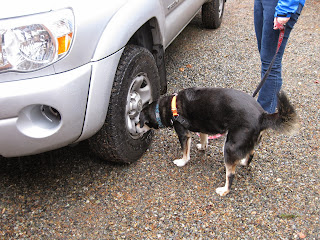On Saturday, after much begging, my husband agreed to go with me and take pictures and video. The event was being held on private property in Gig Harbor. When we drove up the driveway, I suddenly felt I was in heaven. There was an empty horse pasture, an open field and grass that sloped down the hill. The house and barn sat on 40 acres of land, much of which was wooded.
Everyone parked in the pasture, lined up on the grass in a neat row.
The Sniff & Go was for Level 1, 2 and 3 hides consisting of both vehicle and exterior searches. We arrived at 10 am for Level 1. Level 1 hides are done only with birch.
The organizers offered coffee and a warm place to rest inside the barn. The temperature was in the 30s when we left home in the morning. I had dressed in several layers, including thermal underwear and tights as I knew we would be outside for a long time. The warm barn was a wonderful surprise!
The instructors explained how the Sniff & Go would run and then we did a walk-through of each of the search areas, the boundaries marked by orange flags. What I liked was that they emphasized the atmosphere was intended to be relaxed and encouraged us to ask questions if we had them. We would be timed, but there would be no placements and we were free to go when we were finished with our searches. We were divided into two groups so that each group could be running simultaneously. The lower set of searches consisted of two exterior searches and one vehicle hide. Then the higher set of searches consisted of one exterior search and one vehicle hide.
Pongo and I were the second dog-handler team in the first group. When it was our turn, we queued up by the orange cones to the first exterior search. You will notice in the video below that Pongo alerts to the odor within seconds, but I don't recognize it and we continue searching. I ask the judges a question about search boundaries, and then Pongo brings me right back to where he pointed it out before.
Pongo had found the odor so quickly that I didn't trust him. No, similar to his ORT for anise, he had to tell me twice before I believed him. If you watch the video closely, he looks right at me the first time and even jumps toward me, as if to say, "I found it, where's my reward?"
You can reward your dog at the source with treats during a trial, but if you drop them on the ground, you contaminate the area and are given a "fault." They have to eat the treat directly from your hand. The time limit for this search was 2 minutes 30 seconds. Pongo "officially" found it when I called alert at 54 seconds. I was thrilled! The power of his nose continually amazes me, maybe because we are new to this sport.
The next element was a vehicle search, again with a time limit of 2 minutes and 30 seconds. There were three vehicles parked on a slight downhill. This time, I called a false alert when Pongo was "in odor" meaning he was near, but had not identified the source. We finished in 1 minute and 12 seconds.
The next search was held inside a fenced tennis court with a time limit of 3 minutes. I chose to keep Pongo on leash, as I was afraid he would fixate on searching the perimeter in his excitement in being in a new place. Pongo found the odor in 34.87 seconds. Way to go, Pongo!!!
The judges kept track of our search data on a piece of paper. Here I am showing my husband our results as I walk from the lower to the higher search area.
The next exterior search was near a building and had a time limit of 2 minutes 30 seconds. Again, Pongo found it quickly in 37.03 seconds. I was over the moon!
Our final search was another vehicle search. This one proved to be the most difficult for us. With a time limit of 2 minutes 30 seconds, we finished in 1 minute 54 seconds. However, I again gave a false alert when he was on the fringe of the odor. It turned out that he was scenting on odor on one vehicle that was actually blowing from different vehicle behind me. The judge noted that I was blocking the odor.
So in our first trial situation, Pongo correctly identified 3 out of 5 hides! The only two we failed were the vehicle searches, and we only started doing those two weeks ago! We did better than I had anticipated, and I was beaming with pride. My biggest fear about trials is whether or not I will be able to accurately read what Pongo is telling me. The art of nose work is in the lines of communication developed between you and your dog. I have seen dogs that give very clear signals that they have found the odor - they stop and look at their owner, or will even sit. I worried because Pongo didn't do any of these things - or so I thought. Now my video tells a different story. But when Pongo doesn't seem to give a clear signal, the judge told me to "watch his nose." It worked! I am learning to read Pongo's signals better. We are communicating!
Maybe we will enter a trial in a few months, just as a practice run. Like Jason Heng and his dog, maybe it will take us four times before we pass. And that's ok! We're just having fun.
















